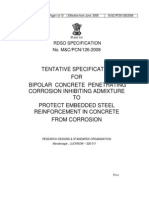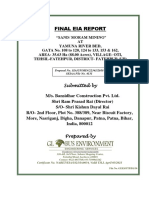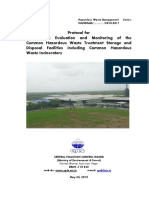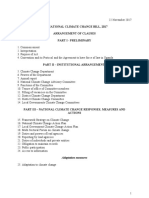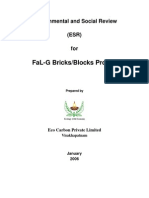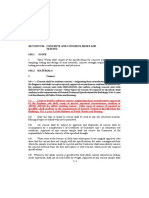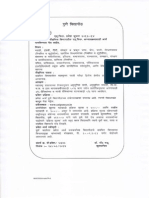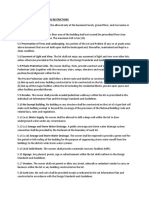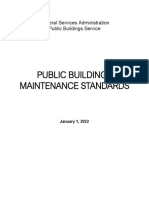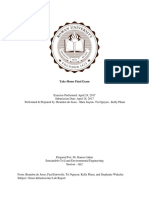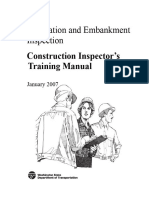CREP Guidelines
CREP Guidelines
Uploaded by
amol76Copyright:
Available Formats
CREP Guidelines
CREP Guidelines
Uploaded by
amol76Original Description:
Copyright
Available Formats
Share this document
Did you find this document useful?
Is this content inappropriate?
Copyright:
Available Formats
CREP Guidelines
CREP Guidelines
Uploaded by
amol76Copyright:
Available Formats
CHARTER ON CORPORATE RESPONSIBILITY FOR ENVIRONMENTAL PROTECTION
CHARTER ON CORPORATE RESPONSIBILITY FOR ENVIRONMENTAL PROTECTION ACTION POINTS FOR 17 CATEGORIES OF INDUSTRIES CENTRAL POLLUTION CONTROL BOARD MINISTRY OF ENVIRONMENT & FORESTS March 2003
CONTENTS
1. 2.
Preface Industry Sectors: action points (i) (ii) (iii) (iv) (v) (vi) (vii) Aluminum . 3. Cement 5 Chlor- Alkali .. 7 Copper 8
Distillery . 9 Dyes & dye intermediates .. Fertilizer . 13 16 11
(viii) Integrated Iron & Steel .. (ix) (x) (xi) (xii) Oil Refineries 19 Pesticides . 21 Petrochemicals 24 Pharmaceuticals . 27
(xiii) Pulp & paper .. 29 (xiv) (xv) (xvi) Sugar .. Tannery . 30 31 34
Thermal Power Plants . 37
(xvii) Zinc
CHARTER ON CORPORATE RESPONSIBILITY FOR ENVIRONMENT PROTECTION (CREP) PREFACE 1. Industrial development is an important constituent in our pursuits for economic growth, employment generation and betterment in the quality of life. On the other hand, industrial activities, without proper precautionary measures for environmental protection are known to cause pollution and associated problems. Hence, it is necessary to comply with the regulatory norms for prevention and control of pollution. Alongside, it is also imperative to go beyond compliance through adoption of clean technologies and improvement in management practices. Commitment and voluntary initiatives of industry for responsible care of the environment will help in building a partnership for pollution control. This is the very purpose of this Charter. 2. With this in view, a series of industry- specific interaction meetings have been organized as per details given below, to formulate the Charter on Corporate Responsibility for Environmental Protection (CREP). Sr. No. Industrial sector 1. 2. 3. 4. 5. 6. Aluminium Cement Chlor Alkali Copper Distillery Dyes & dye intermediates 7. 8. 9. 10. 11. Fertilizer Iron & Steel Oil Refineries Pesticides Petrochemicals Ahmedabad by GPCB Kolkata by WBPCB Guwahati by APCB Ahmedabad by GPCB Guwahati by APCB 08.01.2003 12.12.2002 10.01.2003 07.01.2003 09.01.2003 Workshop Organized at Kolkata by WBPCB Ballabgarh by NCB Ahmedabad by GPCB Kolkata by WBPCB Mumbai by MPCB Ahmedabad by GPCB Date 12.12.2002 05.12.2002 08.01.2003 12.12.2002 03.01.2003 07.01.2003
12. 13. 14. 15. 16. 17.
Pharmaceuticals Pulp & Paper Sugar Tannery Thermal Power Plants Zinc
Harderabad by APPCB Lucknow by UPPCB Mumbai by MPCB Chennai by CLRI Delhi by CPCB Kolkata by WBPCB
11.12.2002 14.12.2002 03.01.2003 02.01.2003 23.12.2002 12.12.2002
3.
The action points enlisted in the charter are addressed to corporate bodies as well as regulatory agencies. Thus, the charter is a commitment for partnership and participatory action of the
concerned stakeholders. The charter is also a road map for progressive improvement in environment management system.
Thus, it is not necessarily limited to compliance of end-of-the-pipe effluent and emission standards. In a number of industrial sectors, the targets set in the charter are ahead of effluent and emission standards. During interaction meetings, the representatives of some industrial sectors sought extension of time to meet the regulatory norms because of techno-economic constraints. In case of units falling in such industrial sectors, time bound action had been proposed in the Charter. This measure has been agreed on the understanding that a bank guarantee would be furnished by the concerned units indicating the commitment to the action plan. However, this is without any prejudice to the stipulations made in the existing standards and action already taken/ initiated for the compliance and area- specific requirements warranting stringent actions. 4. The industrial units which are not complying with the national standards notified under the Environment (Protection) Act, 1986, will submit action plan to meet the standards and bank guarantee to respective State Pollution Control Board within 3 Months (by June, 2003).
1.0 Sr. No. 1.
LUMINIUM INDUSTRY Issues Technology Action points Targets
2.
Fluoride Emissions
Allowing Potlines only Environment clearance with Pre-baked new potlines to be given Technology by MoEF, after June 2003, only with prebaked technology Prescribing maximum Maximum size of the size of the plant plant shall be decided based on the assimilative capacity of each plant location. Revision of fluoride For Soderberg emission standard Technology 2.8 kg/t by December 2005 [1.0kg/t (VCS) & 1.30 kg/t 9HSS) by December 2010]*
Phasing Scrubbing fluoride
For Pre-baked out Wet Technology 0.8 kg/t System for By December 2006
Environmental clearance Allowing new Potlines for new potlines shall be only with Dry Scrubbing given by MoEF, after System June 2003, only with Dry Scrubbing System. To start with Indal or any other better method & Monitoring of fugitive submit data from emissions from pot January 2004, regularly rooms to SPCBs & CPCB
3.
Fluoride Consumption
Fluoride consumption [For Soderberg tonne of aluminum Technology 15 kg/t by produced (as F) December 2005 For Pre-baked technology
4.
Ambient Fluoride
10kg/t by December 2005]* Forage fluoride standards * Twelve consecutive months average-40 ppm * Two consecutive months Average- 60 ppm * One month 80 ppm
5.
6.
7.
To start monitoring and submit data from Measurement of forage January 2004, regularly fluoride to SPCBs & CPCB. The locations of monitoring may be selected in collaboration with SPCBs & CPCB Spent Pot Lining Setting up a centralized [Proposal to be (SPL) SPL treatment & disposal prepared]* facility with aluminum fluoride recovery and utilization of SPL in steel/ cement industries Limit for pot life, (for new pots installed after [2500 days (average)]* December 31, 2003 SPL (Carbon & Refractory) to be disposed in Secured With immediate effect Landfill Red Mud Phasing Wet disposal To achieve minimum Red Mud utilisation 50% solids in red mud by Dec. 2005 A proposal for practical utilization to be prepared by Aluminium Association of India within six months Anoda Baking Achieving particulate By Dec. 2005 Oven matter limit of 50 mg/Nm3
* National task Force will submit the proposal within three months
2.0 CEMENT INDUSTRY 1. Cement Plants, which are not complying with notified standards, shall do the following to meet the standards; Augmentation of existing Air Pollution Control Devices Replacement of existing Air Pollution Control Devices 2. by July 2003 by July 2004
Cement Plants located in critically polluted or urban areas (including 5 km distance outside urban boundary) will meet 100 mg/ Nm3 limit or particulate matter by December 2004 and continue working to reduce the emission of particulate matter to 50 mg/Nm3.
3.
The new cement kilns to be accorded NOC/Environmental Clearance w.e.f 01.04.2003 will meet the limit of 50 mg/Nm3 for particulate matter emissions.
4. 5.
CPCB will evolve load based standards by December 2003. CPCB and NCBM will evolve SO2 and NOx emission standards by June 2004.
6.
The Cement industries will control fugitive emissions from all the raw material and products storage and transfer points by December 2003. However, the feasibility for the control of fugitive emissions form limestone and coal storage areas will be decided by the National Task Force (NTF). The NTF shall submit its
recommendations within three months. 7. CPCB, NCBM, BIS and Oil refineries will jointly prepare the policy on use of petroleum cokes as fuel in cement kiln by July 2003. 8. After performance evaluation of various types of continuous monitoring equipment and feedback form the industries and equipment manufactures, NTF will decide feasible unit operations/ sections for installation of continuous monitoring equipment. The industry will install the continuous monitoring systems (CMS) by December 2003
9.
Tripping in kiln ESP to be minimized by July 2003 as per the recommendations of NTF.
10.
Industries will submit the target date to enhance the utilization of waste material by April, 2003.
11.
NCBM will carry out a study on hazardous waste cement kiln by December 2003.
utilization in
12.
Cement industries will carry out feasibility study and submit target dates to CPCB for co-generation of power by July 2003.
Non complying units shall given bank guarantee to respective SPCBs.
3.0 1. 2. 3.
CHLOR- ALKALI INDUSTRY Complete recycling of mercury bearing effluent by December 2003. Installation of continuous on-line mercury analyzer by June2003. Treatment of cell-room ventilation gas limit for mercury not to exceed 1 gm/t of product by December 2005.
4.
De-mercerisation of caustic soda & limit for mercury in caustic soda at 0.1 gm/of product by December 2004.
5. 6.
Reduction of mercury in H2 gas at 0.5 gm/t by December 2004. Installation of common full-fledged salt washery unit at source by Dec. 2003.
7.
Capping existing completed disposal sites by June 2004 (Action plan to be submitted by June 2003).
8. 9.
Installation of mercury distillation units by June 2003. Brine sludge treatment and water leachable mercury content in brine mud at < 0.1 mg/I before disposal in Secured Landfill.
10.
Reduction of mercury consumption at < 50 gm/t of product by December 2005.
11.
Total mercury release to environment at < 2.0 gm/t of product by December 2005.
12.
The mercury cell plants will switch over to membrance cell technology in a time bound manner for which action plan will be prepared by respective plants within six months.
13.
Industry to submit action plan covering the pollutional and safety aspects for CI2 handling to prevent any accident/ release of CI2 within three months.
4.0 1.
COPPER INDUSTRY To meet SO2 emission limit ( 2kg/tonne of H2 SO4 produced). 50 mg /Nm3 of acid mist by December 2005. Action plan to be submitted by July 2003.
2.
SO2
Emissions
monitoring:
Installation
Proper
operation,
maintenance and calibration of continuous SO2 monitoring system by 30th June 2003. 3. 4. Proper operation and maintenance of tailing dams. Wastewater treatment and disposal: To achieve Zero discharge through 100 recycle reuse of treated wastewater by 31 st Dec. 2003. 5. House Keeping: To reduce the generation of fugitive dust from vehicle movement and improve overall house keeping by 31 st Dec. 2003. 6. Green Belt: To develop canopy based green belt around the periphery of plant and township as per CPCB guidelines. 5.0 DISTILLERIES Existing Molasses Based Distilleries will furnish bank guarantee and Action Plan to concerned State Board to ensure compliance with any combination of the following measures; 1 Compost making with press mud/agricultural residue/ Municipal Waste: I II Concentration and drying/ Incineration: treatment of spentwash through biomethanation followed by two stage secondary treatment and dilution of the treated effluent with
process
water
for
irrigation
as
per
norms
prescribed
by
CPCB/MoEF. IV Treatment of spentwash through bio- machination following by secondary treatment (BOD < 2500 mg/I) for controlled discharge into sea through a proper submerged marine outfall at a point permitted by SPCB/CPCB in consultation with National Institute of Oceanography (NIO), so that Dissolved Oxygen in the mixing zone does not deplete, less than 4.0 mg/I. V. For taking decision on feasibility of one time controlled land application of treated effluent, a study will be under taken within three months. The road map for utilization of spentwash by the distilleries to achieve zero discharge of spentwash in inland surface water courses will be as below:50% utilization of spentwash 75% utilization of spentwash 100% utilization of spentwash - By March, 2004 - By March, 2005 - By December, 2005
The 100% utilization of spentwash is achieved, controlled and restricted discharge of treated effluent form lined lagoons during rainy season will be allowed by SPCB/CPCB in such a way that the perceptible colouring of river water bodies does not occur. 1. Monitoring Task Force consisting of CPCB, SPCB, Experts and industry shall be constituted for monitoring the implementation of action points. 2. New Distilleries & Expansion of Existing Distilleries ( Mollasses based) Proposal for Standalone new distilleries and expansion of exiting distilleries will out achieving zero discharge in surface water/ ground water will not be considered MoEF/ SPCB. * to be decided by SPCB/ CPCB/ MoEF.
6.0 DYES & DYE INTERMEDIATES
Wastewater Management 1. Industry Associations will conduct feasibility study for adoptions of cleaner technologies for HAcid manufacture (Catalytic
hydrogenation and others ) Within one year. 2. Industries will submit a proposal for recovery and purification by June 2003. 3. Dye intermediate industries will install salt recovery systems in case of sodium sulphate from dyestuff and reuse recovered salt in the process by December 2003. 4. An action plan for installation /up gradation of incineration systems as per CPCB guidelines to handle concentrated wastewater and reuse of treated weak wastewater will be submitted within six months. 5. Industry Associations will encourage waste exchange for proper use of weak acids. ( Action within one year ) 6. Wherever possible waste generated from one industry will be utilized by others ( e.g use of effluent generated from Vinly Sulphone plant
in H- Acid plant). Action plan in this regard will be submitted by April 2004. 7. Industries will regularly monitor ground water quality. This will be initiated immediately. 8. H- Acid industries will examine the feasibility to increases product yield form 1.09 to 1.86 for reducting iron sludge, within six months. 9. In case of dyestuff, wherever possible ( to be decided by the task Force within six months), industries will use spray drying instead of salting to minimize load on Effluent Treatment Plants. 10. Industries will submit proposal on adoption of waste minimization practices by June 2003. 11. Existing standards will be reviewed in consultation with industries. Action in this regard will be taken within six months. Air Pollution Management
1.
Industries will minimize loss of volatile organics (solvent recovery of at lead either individually or collectively. An action plan will be submitted by June 2003.
2.
Scrubbing systems for Sox and NOx emission will be upgraded by July 2003.
Solid Management Proper on site storage facilities and final disposal of solid waste on secured landfill will be ensured immediately. Better Management Practices Improvement of house keeping such as concreting of floors, sealing of breaches/leakages in the system, replacement of corrosive pipenes, etc to prevent spillages, leakages, fugitive emissions will be done three months. 7.0 FERTILIZER INDUSTRY Wastewater Management 1. Efforts will be made for conservation of water, particularly with a target to have consumption less than 8.12 and 15 m3 tonne of urea produced for plant based on gas, naphtha and fuel oil, respectively. In case of plants using Naptha and Gas both as feed stocks, water consumption target of less than 10m3/ tonne will be achieved. An action plan for this will be submitted by June 2003 and targets be achieved by March 2004. 2. Use of arsenic for CO2 absorption in ammonia plants and chromate based chemicals for cooling system, which is still continuing in some industries, will be phased out and replaced with non- arsenic and non- chromate systems by December 2003. In this regard, action plan will be submitted by June 2003. 3. Adequate treatment for removal of oil, chromium (till non- chromate based cooling system is in place) and fluoride will be provided to meet the prescribed standards at the source (end respective process unit) itself. Action plan will be firmed up by June 2003 for compliance by March 2004.
4.
Proper and complete nitrification and de-nitrification will be ensured wherever such process used for effluent treatment, by September 2003,
5.
Ground water monitoring around the storage facilities and beyond the factory premises will be carried out at regular intervals particularly for pH. Fluoride CPCB will finalize the guidelines for groundwater monitoring by December 2003.
6.
No effluent arising from process plants and associated facilities will be discharged to the storm water drain. The quality of storm water will be regularly monitored by all the industries.
7.
The industries, where waste water/ effluent flows through the storm water drains even during the dry season will install continuous systems for monitoring the storm water quality for pH, ammonia and fluoride. If required, storm water will be routed through effluent treatment plant before discharging. An action plan will be submitted by June 2003 and necessary action will be taken by June 2004.
Air Pollution Management 1 All the upcoming urea plants will have urea prilling towers based on natural draft so at to minimize urea dust emissions. 2. The existing urea plants particularly, the plants having forced draft prilling towers will install appropriate systems ( e.g. scrubber. etc.) for achieving existing norms of urea dust emissions. In this regard, industries will submit action plan by June 2003 and completion of necessary actions by June 2004. 3. The sulphuric acid plants having SCSA system will switch over to DCDA system by March 2004 to meet the emission standard for SO2 as 2kg/tonne of H2SO4 produced. An action plan for this will be submitted by June 2003. 4. Sulphuric acid plants having DCDA system will improve the conversion and absorption efficiencies of the system as well as scrubbers to achieve SO2 emission of 2kg tonne of acid produced in
case of plants having capacity above 300 tpd and 2.5 kg tonne in case of plants having capacity upto 300tpd. An action plan will be submitted by June 2003 and emission levels will be complied with by September 2004. 5. Stack height for sulphuric acid plants will be provided as per the guidelines and on the basis of normal plant operations (and not when the scrubbers are in use )by June 2003. The scrubbed gases are to be letout at the same height of the stock. 6. An action plan for providing proper dust control systems rock phosphare grinding unit in phosphoric acid plants/ single super phosphate plants, so as to achieve particulate emission of 150 mg/Nm3 will be submitted by September 2003 and complied with by March 2004. 7. Particulate as well as gaseous fluoride will be monitored and adequate control systems will be installed by June 2004 to achieve the norms on total fluoride emissions (25 mg/Nm3). 8. Continuous SO2 emission monitoring systems will be installed in sulphuric acid plants ( having capacity 200 tpd and above) by March 2004. Action plan for this will be submitted by June 2003. 9. Regular monitoring of ambient air quality with regard to SO2 NOx, PM, SO3, fluoride and acid mist will be carried out. Solid Waste Management 1. Gypsum will be effectively managed by providing proper lining, dykes with approach roads and monitoring of groundwater quality around storage facilities. Accumulated gypsum will be properly capped. In this regard, action plan will be submitted by June 2003 and for compliance by December 2003. 2. An action plan for proper handling, storage and disposal of spent catalyst having toxic metals will be submitted by June 2003 and implemented by September 2003. The industry will also explore recovery/buy-back of spent catalyst by September 2003.
3.
Carbon slurry, sulphurmuck and chalk will be properly managed and disposed of in properly designed landfill either within premises or in common facility. Action plan on this will be submitted by June 2003 and implemented by March 2004.
4.
Existing stock of chromium and arsenic bearing sludge will be properly disposed by December 2003. industries will also explore recovery of chromium from the sludge. CPCB will provide guidelines for proper disposal of the sludge.
8.0 INTEGRATED IRON & STEEL INDUSTRY 1. Coke Oven Plants To meet the parameters PLD(% leaking colors), PLL (% leaking lids), PLO (% leaking off take), of the notified standards under EPA within three years by December 2005). Industry will submit time bound action plan and PER Chart along with the Bank Guarantee for the implementation or the time. To rebuild at least 40% of the coke oven batteries in next 10 years ( by December 2012.). 2. Steel Melting Shop Fugitive emissions To reduce 30% by March 2004 and
100% by March 2008 (including installation of secondary dedusting facilities). 3. Blast Furnace * 4. Direct inject of reducing agents ---------- by June 2013.
Solid Waste /Hazardous Waste Management Utilization of Steel/ Melting shop (SMS)/ Blast Furnace (BF) Slag as per the following schedule: * * * By 2004 - 70% By 2006 80% and By 2007 100 %.
Hazardous Wastes Charge of tar sludge/ ETP sludge to Coke Oven by June 2003.
Inventorization of the Hazardous waste as per Hazardous Waste (M& H), Rules, 1989 as amended in 2000 and implementation of the Rules by Dec. 2003. ( tar sludge, acid sludge, waste Lubricating oil and type fuel falls in the category of Hazardous waste).
5.
Water Conservation/ Water Pollution To reduce specific water consumption to 5 m3/t for long products and 8 m3/t for flat products by December 2005. To operate the Co-BP effluent treatment plant efficiently to achieve the notified effluent discharge standards. by June 2003.
6.
Installation of Continuous stack monitoring system & its calibration in major stacks and setting up of the online ambient air quality monitoring stations by June 2005.
7.
To operate the existing pollution control equipment efficiently and to keep proper record of run hours, failure time and efficiency with immediate effect. Compliance report in this regard be submitted to CPCB/SPCB every three months.
8.
To implement the recommendations of Life Cycle Assessment (LCA) study sponsored by MoEF by December 2003.
9.
The industry will initiate the steps to adopt the following clean technologies measures to improve the performance of industry towards production, energy land environment. Energy recovery of top Blast Furnace (BF) gas. Use of Tar- free runner linings. De- dusting of Cast house at tap holes, runners, skimmers ladle and charging points. Suppression of fugitive emissions using nitrogen gas or other inert gas
To study the possibility of slag and fly ash transportation back to the abandoned mines, to the abandoned mines, to fill up the cavities through empty railway wagons while they return back to the mines and its implementation.
Processing of the waste containing flux & ferrous wastes through waste recycling plant.
To implement rainwater harvesting Reduction Green House Gases by : * * * Reduction in power consumption Use of by products gases for power generation Promotion of Energy Optimisation technology including energy/ audit
To se targets for Resource Conservation such as Raw material, energy and water consumption to match International
Standards. Up- gradation in the monitoring and analysis facilities for air and water pollution. Also to impart elaborate training to the manpower so that realistic data is obtained in the
environmental monitoring laboratories. 10. To Improve overall house keeping.
Sponge lron Plants Inventorisation of sponge iron plants to be completed by
SPCBs/CPCE by June 2003 and units will be asked to install proper air pollution control equipment by December 2003 to control primary and secondary emissions. As per rebuilding schedule submitted to CPCB/MoEF. 9.0 OIL REFINERIES Air Pollution Management 1. All the refineries located in the critically pollution areas, identified by CPCB, will submit an action plan ( within six months) for phase wise reduction of SO2 emission from the present level.
2.
Future refineries will have Sulphur Recovery Unit (SRU) with minimum 99% efficiency.
3.
To enhance the efficiency of SRUs in the existing refineries, an expert committee will be constituted to look into various aspects and suggest a road map within six months.
4.
With regard to NOx emission, the new refineries/process units will install low NOx burners. For retrofitting of low NOx burners in existing units, the expert committees will suggest the strategies and action plan within six months including NOx standard.
5. 6.
The flare losses will be minimized and monitored regularly. Refineries will install continuous emission monitoring systems for SOx and NOx in major stacks with proper calibration facilities. Action plan for this will be submitted within six months.
7.
Refineries will also monitor total HO and Benzene in the premises (particularly at loading loading operations and ETP). The status and action plan will be submitted within six months. The expert committee will also suggest an action plan, within six months, for contract and monitoring of hydrocarbon loss & VOC emissions. leak detection and repa (LDAR) programme and vapour recovery systems ( for loading & unloading operations within refineries only).
Wastewater management 1. Refineries will prepare action plan for conservation of water resources and maximized reuse recycling treated effluent within six months. The treated effluent discharge quantity (excluding once through cooling water) will be limited to 0.4 m3/per tonne ( for 90% of time ) except for the monsoon season. 2. Oil spill response facilities at coastal refineries will be in position within two years. To facilitate this MoEF will coordinate with Coast Guards. Port Trust and departments. Solid Waste Management
1.
Refineries will explore new technologies for reduction in the generations of oils sludge Strategy and action plan for liquidation of existing sludge will be submitted within six months
2.
The petroleum coke having high sulphur content will be sold to /reused by organized industries (having consent from SPCBs), which have systems to control SO2 emissions. This will be ensured by June 2003.
10.0 PESTICIDES INDUSTRY
1. Segregation waste streams Waste streams should be segregated into COD waste, toxic waste, low OCD waste, inorganic waste etc, for the purpose of providing appropriate treatment- Implementation June 2003 and action plan to be submitted to SPCB immediately. 2. Detoxification and treatment of high COD waste streams Streams should be detoxified and treated in CTP or thermally destroyed in incinerator, as per CPCB guidelines. The waste streams should be treated suitably before taking to evaporation ponds. Implementation by June 2004 and action plan to be submitted to SPCB by June 2003.
3.
Improvement in solvent recovery a) Solvent recovery should be improved and attempts be made to achieve atleast 90% recovery wherever possible-
Implementation by Dec. 2003 and action plan to be submitted to SPCB by June 2003. b) Rest of the solvents which can not be recovered shall be incinerated . 5. Hazardous air pollutant control (a) For air pollution control from processes, scrubber efficiency will be improved and maintained as per the best practicable
technology for control of HCI, CI. Methyl Chloride, Phosphorus Pentoxide, Ammonia, H2S and volatile organic carbons (VOCs)Implementation by December 2003 and action plan to be submitted to SPCB by June 2003. (b) An incinerator will be installed, where necessary
Implementation by December 2004 and action plan to be submitted to SPCB by June 2003. 6. Control of fugitive emissions/ VOCs For control of fugitive emissions (particularly) for hazardous air pollutions). The industries will adopt standard engineering practices. System of leak detection and repair (LDAR) programme especially for solvents, should be developed industries- implementation by March2004 and action plan to be submitted to SPCB by June 2003. 7. Up- gradation of incinerators Incinerators will be upgraded to meet CPCB norms hazardous waste incinerators. This is necessary for Halogenated compound and POPs Implementation target will be decided on the basis of action plan submitted by individual industries by June 2003. 8. Replacement of Bio Assay test by toxicity Factor The present bio-assay test will be replaced by Toxicity Factor test method developed by CPCB. Toxicity factor of four (TF-4) will be achieved by December 2003 and industries will improve their system to achieve TF-2 by, July 2006. TF test method will be implemented by SPCBs/CPCB/ MoEF- Submission of action plan by June 2003. The Central Pollution Board will organize work shops on Toxicity Factor for industry. 9. Minimum scale of production to afford cost of pollution load. To be decided, as industries view point is that this can not be done as few products are costly and made in small volume. The matter will be studied in detail by MoEF/ CPCB.
10.
Non- complying Units (as identified by SPCB) should meet the notified standards by December 2003- Bank guarantee to be submitted to SPCB by Non- complying units by June 2003. The submissions from pesticides industry regarding speedy clearance and other will be considered by MoEF/ CPCB for examination.
11.0 PETROCHEMICALS
1. Adoption of state-of- art technology State of Art technology will be adopted for both process technology as well sound engineering practices required for control of emission, at the stage of design itself in case of new plants 2. Management of storm water For the storm water generated from process area and tank farm area during initial hours of rain. An arrangement will be made for collection and oil separation including further treatment as required. Such arrangement will include provision for buffer tank (holding tank) and monitoring of effluent quality. This will be accomplished by June 2003. 3. Effective detoxification and waste water treatment scheme. In order to control high COD and persistent organic pollution including toxic constituents, the industry will select appropriate unit operations for pre-treatment of effluent within inside battery limit (ISBL) before sending to the biological treatment systems for better functioning of ETPs. Action plan for the same will be submitted within 6 months and implemented within one year (March, 2004) 4. Control of emission from combustion The industry will submit an action plan within six months for improving thermal efficiency and control of NOx. 5. Proper functioning of point source emission control systems The industry will make efforts for proper operation of pollution control system (mostly scrubbers) and attainment of desired efficiency within six months. The will include backup of power
supply to the control equipment and arrangement for frequent sampling and analysis of all critical pollution in the tall gases. 6. Leak detection and repair (LDAR) programme As a good operating, the industry will adopt periodically leak detection and repair (LDAR) programme to check fugitive emissions within six months. The frequency of the programme will be proportionate to the risk potential of carrying fluid. Based on leak detection as per LDAR programme, action will be taken to eliminate fugitive emissions. this will be a continuous activity. 7. Handling of halogenated organics The industry will submit an action plan within 6 months to ensure that no halogenated organics is sent to the flares in order to avoid formation of persistent organic pollutants. All HAPs had
halongenated organics will be routed to the incineration system having end- on pollution control facility. 8. Control of fugitive emissions of carcinogenic compounds Fugitive emissions of carcinogenic compounds (e.g Benzene) will be controlled by closed vapor collection and recovery system. Measures will be taken to monitor health of the work 9. Management of solid waste Proper facilities will be provided for handling and storage of hazardous waste with manifest system in case transported to other places. For incinerable waste, properly designed incinerator will be installed within the premises or as a common facility. The nonincinerable hazardous waste should be disposed of in a secure-land fill. 10. Proper operation of incinerator Industry will check the design and will adopt sound engineering practices for proper operation of incinerators. Continuous
monitoring will be done for operational parameters and specific
parameters in tail gas to ensure the efficient functioning. This will be implemented within 3 months. 11. Optimising the inventory of hazardous chemicals Efforts will be made to optimize the inventory, particularly of hazardous chemicals. Such information will be made available to the Regulatory Agencies (SPCBs). Inspector of Factory & District Collector. 12. Self regulation by industry through monitoring and environmental auditing. Industry will go for self assessment and regulation by conducting environmental auditing regularly, besides having regular monitoring of pollutants in air emission, liquid effluent and receiving
environment. 13. Organizational restructuring and accreditation of environmental manager of industry For self-evaluation, organizational restructuring will be done and the environmental manager of the industry will be accredited to bring professionalism in environmental management. 12.0 PHARMACEUTICALS 1. Segregation of waste streams Waste streams should be segregated into high COD waste toxic waste, low COD waste, inorganic waste etc, for the purpose of providing appropriate treatment. Implementation by December, 31, 2003 and action plan to be submitted to SPCB by June 30, 2003. 2. Detoxification and treatment of high COD waste streams High COD streams should be detoxified and treated in XTP or thermally destroyed in incinerator Implementation by March 2004 and action plan to be submitted to SPCB by June 2003. 3. Management of solid waste Proper facilities should be provided for handing and storage of hazardous waste. For final disposal of hazardous waste, recycling and reuse should be given priority, either within the premises or
outside with proper manifest system. In case of incinerable waste, property designed incinerator should be installed within the premises or outside as a common facility. The non-incinerable hazardous waste should be disposed of in properly designed securelandfill either within the industrys premises or in a common facilityimplementation by march 2004 and action plan to be submitted to SPCB by June 2003. 4. Minimum scale of production to afford cost of pollution control For new industries which are not connected with CETP & TSDF and which do not have the economics to install treatment facilities may not be considered for granting consent to establishment. Industry association shall submit proposal to SPCB/CPCB implementation by December 31, 2003 and action plan to be submitted to SPCB by June 30, 2003. 5. Long term strategies for reduction in waste Consent for establishment and consent for operation under the Water Act will be based on pollution load and concentration of pollutants. Each industry will submit pollution load, concentration of final discharge alongwith water balance to SPCB/CPCB for formulation of strategy action plan to be submitted to SPCB by June 30, 2003. 6. Control of air pollution Industry will take up in priority the control of hardous air pollutants (such as benzene carbon tetrachloride 1-4 diocane, methanol, toluene, methyl chloride etc). and odorous compounds (mecapatan & hydrogen sulphide) Implementation by Dec. 2004 and action plan to be submitted to SPCB by June 2003. 7. Self regulation by Industry through regular monitoring and environmental auditing Industries on their will carry out monitoring environmental parameters, audit it at regular interval and submit the same to SPCB- Implementation by June 2003.
Comment of BDMA- There shall be a policy for accreditating the auditors and the policy guidelines may be issued by MoEF. 8. Organistional restructuring and accreditation of Environmental Manager of Industry (a) Environment management cell will be created for each industry reporting to CEO directly- Implementation by June 2003. (b) There should be a certification system for the environmental managers at individual level and common facility level. BDMA may 2003 the programme along with SPCB/ CPCB
Implementation by March 31, 2000 and action plan to be submitted to SPCB by July 2003. 9. Optimizing the inventory of hazardous chemicals The Information shall be submitted to SPCB regularly alongwith rational- action plan to be submitted to SPCB by May 31, 2003.
13.0 PULP & PAPER INDUSTRY Large Pulp and Paper Implementation Schedule Discharge of AOX kg/tonne of AOX 1.5 kg/tonne of paper within 2 paper years AOX 1.0 kg/ tonne of paper in 5 years Installation of lime kiln Within 4 years Wastewater discharge cum/ Less than 140* cum/tonne of paper tonne of paper within 2 years Less than 120 cum/tonne in 4 years for units installed before 1992 Less than 100m3 / tonne of paper per units installed after 1992. Colour control by burning the Installation of odour control system reduced sulfur emissions in within 4 years. the boiler/lime-kiln Utilization of treated effluent Utilization of treated effluent for for irrigation irrigation wherever possible Colour removal from the Indian Paper Manufactures effluent Association to take up project with Central Pulp & Paper Research Institute Small Pulp and Paper
Compliance of standard BOD, COD & AOx
of Recovery of chemicals by installation of Chemical recovery plant or utilization of black liquor with no discharge from pulp mill within 3 years OR Shift to waste paper Upgradation of ETPs so as to ETPs to be upgraded within 1 year so meet discharge standards as to meet dischaaarge standards. Waster water discharge/ tonne Less than 150 cum/tonne of paper of paper within 3 years Utilization of treated effluent Utilization of treated effluent for for irrigation irrigation wherever possible Colour removal from the Indian Agro and Recycled Paper effluent Manufacturers Association to take up project with CPPRI. Note:- Non-complying units not meeting notified standards under Environment (Protection) Act.1986 will submit action plan with PERT Chart along with bank guarantee to SPCBs by June30,2003. 14.0 SUGAR INDUSTRY 1. Waste Water Management Operation of ETP shall be started atleast one month before starting of cane crushing to achieve desired MLSS so as to meet the prescribed standards from day one of the operation of maill. Reduce wastewater generation to 100 litres per tonne of cane by April 2004. To achieve zero discharge in inland surface water bodies by December 2004. To provide 15 days storage capacity for treated effluent to take care of no demand for irrigation by April 2004. 2. Emission Control To install ESP/bag filter /high efficiency scrubber to comply with standards for particulate matter emission to< 150 mg/Nm3 by April 2004.
15.0 TANNERY (i) All the chrome tanning units in the country will have the Chrome Recovery Plant either on individual basis or on collective basis in the form of Common Chrome Recovery Plant and use the recovered chrome in the tanning process by December 2005. (ii) Common Chrome Recovery Plant is to be installed and commissioned at Kanpur by December 2004 for which the Feasibility Report has already been prepared. All the chrome tanning units will make their financial contribution to the extent of 10% by June 2003. (iii) Recovered Chromium is to be utilized in tanning process by December 2004. 2. Waste Minimization Measures (i) Waste minimization circles will be formed in all the clusters of tanneries in the country to implement waste minimization measures and for adoption of clean technologies by March 2004. (ii) Waste minimization measures as identified by the Task Force to be implemented in all the sanneries by December 2005. 3. Reduction of Water Consumption in Tannery Units (i) All the tanneries will install waste meters and flow meters to measure actual consumption and waste water discharge by December 2003. (ii) Waste consumption rates will be brought down to 28m3 /tonne of hides by taking water conservation measures by December 2003. 4. Compliance of Standards All CETPs and ETPs will take the following measuring (i) Deployment of qualified and well trained
6.
Solid Waste Management For solid waste management, the following methods will be adopted. (i) Utilization of Process sludge for by product recovery. By December 2004. (ii) Resource Recovey from process sludge and ETP sludge in the form of Biogas. By : December 2004. (iii) Safe disposal hazardous sludge and non- hazardous solid wastes. By: December 2005.
7.
Salt from Solar Evaporation The following methods will be adopted depending on the site specific conditions: (i) The following methods will be adopted depending on the site specific conditions: (ii) Safe land disposal or Sea disposal wherever required.
8.
Use of Boron bearing compounds will be dispensed with By : December 2003.
9.
Ground water quality monitoring to be strengthened wherever the treated effluents are applied on land for irrigation. By : December 2004.
10.
The
implementation
of
recommendations
of
the
Task
Force
constituted by the Ministry of Environment & Forests, Govt. of India Will commenced by June 2003. Note:Non complying units not meeting notified standards under
Environment (Protection), 1981 will submit action plan with PERT Chart alongwith Bank Guarantee to SPCB by June 30, 2003.
16.0 THERMAL POWER PLANTS 1. Implementation of Environmental Standards (emission & effluent) in non- compliant* Power Plants (31 & 27) Submission of action plan Placement of order for Pollution of control equipment Installation & commission 2005. 2. For existing thermal power plants, a feasibility study whall be carried out by Central Electricity Authority (CEA) to examine possibility to reduce the particulate matter emissions to 100 mg/Nm3. The studies shall also suggest the road map to meet 100 mg/Nm3. The studies shall also suggest the road map to meet 100 mg/Nm3 wherever found feasible. CEA shall submit the report by March 2004. 3. New / expansion power projects to be accorded environmental clearance on or after1.4.1.2003 shall meet the limit of 100 mg/Nm3 for particulate matter. 4. Development of SO2 & NOx emission plants by December 2003. New/ expansion power projects shall meet the limit of SO2 & NOx w.e.f. 1.1.2005. 5. Wxisting power plants shall meet the limit of SO2 & NOX w.e.f. 1.1.2006. Install/activate opacity meters/ continuous monitoring system in all the units by December 31, 2004 with proper calibration system. 6. Development of guidelines/ standards for mearury and other toxic heavy metals emissions by December 2003. 7. Review of stack height requirement and guidelines for power plants based on micro meteorological data by June 2003. 8. Implementation of use of beneficiated coal as per GOI Notification: standards for coal based : : September, 2003 December 31, : June 30, 2003
Power plants will sign fuel supply agreement (FSA) to meet the requirement as per the matrix prepared by CEA for compliance of the notification as short term measure. Options/mechanism for setting up of coal washeries as a long term measure * * * Coal India will up its own washery Sate Electricity Board to set up its own washery Coal India to ask private entrepreneurs to set up washeries for CIL and taking washing charges * SEBs to select a private entrepreneur to set up a washery near pit- head installation of coal beneficiation plant 9. Power plants will indicate their requirement of abandoned coal mines for ash disposal & Coal India/ MOC shall provide the list of abandoned mines by June 2003 to CEA. 10. Power plants will provide dry ash to the users outside the premises or uninterrupted access to the users within six months. 11. 12. Power Plants should provide dry flyash free of cost to the users. State P.W.Ds/ construction & development agencies shall also adhere to the specifications/Schedules of CPWD for ash based products utilization MoEF will take up the matter with State Governments. 13 (i) New plants to be accorded environmental clearance on or after 1.04.2003 shall adopt dry flyash extraction or dry disposal system or Medium (35-40%) ash concentration slurry disposal system or Lean phase with hundred percent ash wate re-circulation system depending upon site specific environmental situation. (ii) Existing plants shall adopt any of the systems mentioned in 13 (i) by December 2004. 14. Flyash Mission shall prepare guidelines/manuals for flyash
utilization by March 2004.
15.
New plants shall promote adoption of clean coal and clean power generation technologies
Units will submit bank guarantee to respective SPCB
17.0 ZINC INDUSTRY 1. Meeting SO2 emission limit ( 2kg/tonne of H2 SO4 produced), 50 mg/Nm3 of acid mist by Dec 2006. Action plan to be submitted by July 2003. 2. SO2 Emissions monitoring Installation/ Proper operation,
maintenance and calibration of continuous SO2 monitoring system by 30th September 2003. 3. Solid and Hazardous Waste disposal: Construction of secured landfill for disposal of hazardous waste such a Jerosite cake, ETP cake and spent catalyst as per CPCB guidelines by 30 th June 2003. 4. Wastewater treatment and disposal: To achieve Zero discharge through 100% recycle/ reuse of treated wastewater by 31 st December 2004. 5. House Keeping: To reduce the generation of fugitive dust from vehicle movement and improve overall house keeping by 31st December 2003. 6. Green Belt: To develop canopy based green belt around the periphery of plant and township as per CPCB Guidelines
You might also like
- Diffirences Between MSMA I & IIDocument93 pagesDiffirences Between MSMA I & IICalvin KewNo ratings yet
- Artigo - Hulya Arslan, 2019 - Síntese de Um Novo Superplastificante À Base deDocument9 pagesArtigo - Hulya Arslan, 2019 - Síntese de Um Novo Superplastificante À Base deLucasNo ratings yet
- Admixtures OlekDocument36 pagesAdmixtures OlekPaul FierroNo ratings yet
- Environmental Quality (Prescribed Activities) (Environmental Impact Assessment) Order 1987Document9 pagesEnvironmental Quality (Prescribed Activities) (Environmental Impact Assessment) Order 1987Ahmad CendanaNo ratings yet
- Geotechnical & Construction Materials InvestigationDocument5 pagesGeotechnical & Construction Materials InvestigationManoj BaralNo ratings yet
- Application of Lob in High Rise StructureDocument6 pagesApplication of Lob in High Rise StructureAnonymous izrFWiQNo ratings yet
- Is 2720 8 1983 PDFDocument14 pagesIs 2720 8 1983 PDFvsshayan_2374207620% (1)
- CalculationDocument14 pagesCalculationLipika KanojiaNo ratings yet
- Tender Document (Tent) (Part-A)Document12 pagesTender Document (Tent) (Part-A)pankajNo ratings yet
- A Handbook of Planning of Office Buildings: Central Public Works Department (CPWD)Document91 pagesA Handbook of Planning of Office Buildings: Central Public Works Department (CPWD)Jatin Chander SinglaNo ratings yet
- OM On Flyash Utilization DTD 28-08-2019Document29 pagesOM On Flyash Utilization DTD 28-08-2019Kumaravel JcNo ratings yet
- Use of Fly Ash in Road Flyover Embankment Construction On NH Works Reg DT On 23rd October 2020 (1) - Compressed - Compressed PDFDocument27 pagesUse of Fly Ash in Road Flyover Embankment Construction On NH Works Reg DT On 23rd October 2020 (1) - Compressed - Compressed PDFLASA VADODARANo ratings yet
- Determining Electric Motor Load and Efficiency: F A C T S H E E TDocument16 pagesDetermining Electric Motor Load and Efficiency: F A C T S H E E TwahonotNo ratings yet
- Gazette Notification - Fly Ash Utilisation Sept 1999Document3 pagesGazette Notification - Fly Ash Utilisation Sept 1999snsgmNo ratings yet
- 3.itp Literature ReviewDocument17 pages3.itp Literature ReviewShyamal PrakashNo ratings yet
- RDSO Tentative SpecificationsDocument13 pagesRDSO Tentative SpecificationsRegina Miller100% (1)
- Admixture Systems Brochure 2016Document20 pagesAdmixture Systems Brochure 2016Gabriel HernandezNo ratings yet
- E WasteDocument14 pagesE WasteSalman ShakirNo ratings yet
- P14+ +Mufid+Al+Samerai+ +presentation - UnlockedDocument123 pagesP14+ +Mufid+Al+Samerai+ +presentation - UnlockedRufus ChengNo ratings yet
- Eia ReportDocument192 pagesEia ReportbarathiNo ratings yet
- 82 Hazardous Waste ManagementDocument64 pages82 Hazardous Waste ManagementakashNo ratings yet
- Customer ComplaintDocument1 pageCustomer Complaintpulkit gargNo ratings yet
- Bottom AshDocument22 pagesBottom AshAnand BG0% (1)
- Building MaterialDocument15 pagesBuilding Materialbirendra prasadNo ratings yet
- Soil Testing LaboratoryDocument13 pagesSoil Testing LaboratoryKesri SharmaNo ratings yet
- IFC EHS Guidelines, Project Finance and Environmental Impact Assessments PDFDocument21 pagesIFC EHS Guidelines, Project Finance and Environmental Impact Assessments PDFleonelNo ratings yet
- CPCB - Hazardous WasteDocument57 pagesCPCB - Hazardous WasteAlan TuringNo ratings yet
- Method of Test For Sand EquivalentDocument6 pagesMethod of Test For Sand EquivalentWissem TaktakNo ratings yet
- Souvenir RAMT2019 PDFDocument72 pagesSouvenir RAMT2019 PDFgkpradhanNo ratings yet
- Activated Carbon Is Method PDFDocument14 pagesActivated Carbon Is Method PDFSaleem BashaNo ratings yet
- Market Study For Aggregates in Greater Hyderabad PDFDocument137 pagesMarket Study For Aggregates in Greater Hyderabad PDFom_833654993No ratings yet
- MoEF IIFM Thermal Power PlantsDocument122 pagesMoEF IIFM Thermal Power PlantsVishal SIngh100% (1)
- Flyash: Characteristics, Problems and Possible Utilization Rupnarayan SettDocument19 pagesFlyash: Characteristics, Problems and Possible Utilization Rupnarayan SettNitish KumarNo ratings yet
- Third Party Quality Control Report As On 20.03.2014Document14 pagesThird Party Quality Control Report As On 20.03.2014Chimakurthy NagarapanchayatNo ratings yet
- EIA Full Report of Neeri On Sethusamudram Ship Channel ProjectDocument427 pagesEIA Full Report of Neeri On Sethusamudram Ship Channel ProjectDr. B. Kaja Magdoom100% (1)
- IPPC - H3 - Part - 2 - Horizontal Guidance Note - Noise Assessment & Control (2002)Document90 pagesIPPC - H3 - Part - 2 - Horizontal Guidance Note - Noise Assessment & Control (2002)mikelotingaNo ratings yet
- Osda Solar Module - Installation ManualDocument21 pagesOsda Solar Module - Installation ManualIOZEF1No ratings yet
- Literature Review On Technical Aspect of Sustainable ConcreteDocument9 pagesLiterature Review On Technical Aspect of Sustainable ConcreteAnneLabacoNo ratings yet
- Is.13630.1-5.2006 CERAMIC TILESDocument50 pagesIs.13630.1-5.2006 CERAMIC TILESBattula SridharNo ratings yet
- S. K. Maiti Book PDFDocument375 pagesS. K. Maiti Book PDFYash AryanNo ratings yet
- Nabet Version 3Document156 pagesNabet Version 3amoNo ratings yet
- Role of Chemical Admixtures in Sustainability - The OpportunityDocument28 pagesRole of Chemical Admixtures in Sustainability - The OpportunityThiagoMaronNo ratings yet
- Mix Design Using Rheology MeterDocument5 pagesMix Design Using Rheology MeterBhupesh MulikNo ratings yet
- AAC Block - A New Eco-Friendly Material ForDocument8 pagesAAC Block - A New Eco-Friendly Material ForHanifhidayaNo ratings yet
- Physical Properties of Pumice and Its Behavior As A Coarse Aggregate in ConcreteDocument11 pagesPhysical Properties of Pumice and Its Behavior As A Coarse Aggregate in ConcreteDelicate BantuNo ratings yet
- Indian Standard: Specification FOR Concrete Masonry UnitsDocument18 pagesIndian Standard: Specification FOR Concrete Masonry UnitsDevendrasinh PadhiyarNo ratings yet
- Fly Ash Building BricksDocument12 pagesFly Ash Building BricksBabor HossainNo ratings yet
- A Simplified Guide To ISO28765 by United Industries Group IncDocument12 pagesA Simplified Guide To ISO28765 by United Industries Group IncGilberto BarettaNo ratings yet
- U2S3-4 - Environmental Impact of Textile IndustriesDocument9 pagesU2S3-4 - Environmental Impact of Textile IndustriesHieu100% (7)
- Hdian Standard: Methods Off Test For Autoclaved Cellular Concrete ProductsDocument10 pagesHdian Standard: Methods Off Test For Autoclaved Cellular Concrete ProductsshailendraNo ratings yet
- CPWD Maintenance Manual 2012Document136 pagesCPWD Maintenance Manual 2012sujeetroyNo ratings yet
- Climate Change Bill 22 Nov 2017 (Draft For Validation Workshop) - 1 PDFDocument102 pagesClimate Change Bill 22 Nov 2017 (Draft For Validation Workshop) - 1 PDFKimbowa RichardNo ratings yet
- EIA Report (9.1)Document350 pagesEIA Report (9.1)imran hossainNo ratings yet
- Fal-G Bricks/Blocks Project: Environmental and Social Review (Esr) ForDocument29 pagesFal-G Bricks/Blocks Project: Environmental and Social Review (Esr) ForchidambaramnklNo ratings yet
- Air Pollution Standards According To IndustriesDocument9 pagesAir Pollution Standards According To IndustriesEzraNo ratings yet
- AbdchtrDocument5 pagesAbdchtrkooolsumitNo ratings yet
- SECTION 5 (Concrete Steel Structures) (FINAL)Document240 pagesSECTION 5 (Concrete Steel Structures) (FINAL)Mohammad SahmoudNo ratings yet
- SECTION 5 (Concrete Steel Structures) (FINAL)Document241 pagesSECTION 5 (Concrete Steel Structures) (FINAL)Yasmin AkramNo ratings yet
- Jharkhand State Pollution Control BoardDocument5 pagesJharkhand State Pollution Control BoardANJANI KUMAR SINGHNo ratings yet
- BOI - Environmental - NormsDocument28 pagesBOI - Environmental - NormsIshara Praneeth WijesuriyaNo ratings yet
- 370243SakalBharati Marathi InstallationGuideDocument1 page370243SakalBharati Marathi InstallationGuideamol76No ratings yet
- Higlights of Latest MERC Tariff OrderDocument1 pageHiglights of Latest MERC Tariff Orderamol76No ratings yet
- Motors - RRMDocument4 pagesMotors - RRMamol76No ratings yet
- List of Civil Contractors & RCC ChimneyDocument2 pagesList of Civil Contractors & RCC Chimneyamol76No ratings yet
- Gmffid: Ffiarqr Q Fffio 1ffi6Document6 pagesGmffid: Ffiarqr Q Fffio 1ffi6amol76No ratings yet
- Annexure-B The Schedule of Revision of Photo Electoral Roll W.R.T. 01/01/2014 As The Qualifying DateDocument1 pageAnnexure-B The Schedule of Revision of Photo Electoral Roll W.R.T. 01/01/2014 As The Qualifying Dateamol76No ratings yet
- Chap 1Document17 pagesChap 1amol76No ratings yet
- Chap 3Document10 pagesChap 3amol76No ratings yet
- CG Pumps: Product CatalogueDocument88 pagesCG Pumps: Product CatalogueAnimesh SahaNo ratings yet
- Siemens LowDocument40 pagesSiemens Lowamol76100% (1)
- CMRI SpecDocument12 pagesCMRI Specamol76No ratings yet
- Index Diary MSEDCl 2013Document165 pagesIndex Diary MSEDCl 2013Sachin KhandareNo ratings yet
- PDF Price List GlandsDocument2 pagesPDF Price List Glandsamol76No ratings yet
- PDF LDC LP Dated 03 Sept 13Document18 pagesPDF LDC LP Dated 03 Sept 13amol76No ratings yet
- RMZ EnvironmentDocument220 pagesRMZ EnvironmentPoulomi BiswasNo ratings yet
- Construction Activity Pollution Prevention Plan - 12oct2023Document17 pagesConstruction Activity Pollution Prevention Plan - 12oct2023JayaprakashNo ratings yet
- City of Johannesburg Draft Stormwater BylawsDocument63 pagesCity of Johannesburg Draft Stormwater BylawsKosikee A. IwuohaNo ratings yet
- Humes Concrete Pipe ManualDocument50 pagesHumes Concrete Pipe ManualCheng KimHua100% (5)
- Going Green - How To Make Our Homes More Eco-Friendly?Document1 pageGoing Green - How To Make Our Homes More Eco-Friendly?Julia WiniarskaNo ratings yet
- 7 9 09Document96 pages7 9 09James DrewNo ratings yet
- Arca South Guidelines and RestrictionsDocument5 pagesArca South Guidelines and RestrictionsJungNo ratings yet
- Green, Complete StreetsDocument2 pagesGreen, Complete StreetsEPA Region 7 (Midwest)No ratings yet
- LandscapeDocument13 pagesLandscapetaapsiiiNo ratings yet
- GRIHA AH V 1 Feasibility Checklist NewDocument18 pagesGRIHA AH V 1 Feasibility Checklist NewAnkush BhartiNo ratings yet
- Glossary of Drainage TermsDocument9 pagesGlossary of Drainage TermsarsabanNo ratings yet
- Watershed Management - OverviewDocument5 pagesWatershed Management - OverviewUtkarsh MishraNo ratings yet
- Drainage Design ReportDocument31 pagesDrainage Design ReportAijazNo ratings yet
- GSA PBS Preventive Maintenance Guide 2022 - 0Document647 pagesGSA PBS Preventive Maintenance Guide 2022 - 0Marc HillNo ratings yet
- Jan 10 2024 MS Connect RFP Response - RedactedDocument53 pagesJan 10 2024 MS Connect RFP Response - Redactedjoshua.hemphillgrayNo ratings yet
- Take-Home Final ExamDocument7 pagesTake-Home Final ExamBhuiyan1No ratings yet
- Littoral Rainforest The SpitDocument16 pagesLittoral Rainforest The Spitapi-527112138No ratings yet
- Lecture 6 - The Rational Method and Intro To Stormwater Drainage Structures - The Rational Method and Intro To Stormwater Drainage StructuresDocument16 pagesLecture 6 - The Rational Method and Intro To Stormwater Drainage Structures - The Rational Method and Intro To Stormwater Drainage StructuresNavjotSingh100% (1)
- Building Utilities Module 2 Lesson 4Document5 pagesBuilding Utilities Module 2 Lesson 4Bryan ManlapigNo ratings yet
- Wicaksono 2023 IOP Conf. Ser. Earth Environ. Sci. 1203 012047Document11 pagesWicaksono 2023 IOP Conf. Ser. Earth Environ. Sci. 1203 012047Raida Ramdhanita HadayaNo ratings yet
- 5-Retention PondsDocument7 pages5-Retention PondsBondoc, Miles Jerome Z.No ratings yet
- Stormwater - Retention Pond (Wet Pond) vs. Detention Pond (Dry Pond)Document2 pagesStormwater - Retention Pond (Wet Pond) vs. Detention Pond (Dry Pond)Lionel Tan100% (3)
- Excavation and Embankment InspectionDocument102 pagesExcavation and Embankment InspectionFITSUM BerheNo ratings yet
- DPR South City 1Document427 pagesDPR South City 1msyncast1No ratings yet
- HumeGard Technical Manual Issue 3 March 2015Document32 pagesHumeGard Technical Manual Issue 3 March 2015Mohd Muzani MustafaNo ratings yet
- Township of Springwater Engineering Standards March 2019Document169 pagesTownship of Springwater Engineering Standards March 2019limapalaveNo ratings yet
- Review of Urban Drainage, 4th Edition, by David Butler, Christopher James Digman, Christos Makropoulos, and John W. DaviesDocument1 pageReview of Urban Drainage, 4th Edition, by David Butler, Christopher James Digman, Christos Makropoulos, and John W. DaviesJhon Edison Bravo Buitrago100% (1)
- Wetland Architecture ThesisDocument8 pagesWetland Architecture ThesisCollegePaperGhostWriterAkron100% (2)
- Livable Streets A Handbook of Bluegreengrey Systems Version 2.0Document90 pagesLivable Streets A Handbook of Bluegreengrey Systems Version 2.0NIKA ADONo ratings yet















